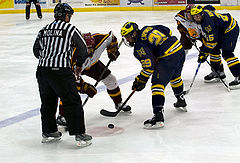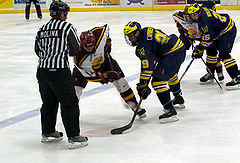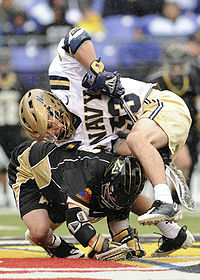- Face-off
-
Series of photos showing the University of Michigan's Louie Caporusso (in the #29 blue jersey) winning a hockey faceoff
A face-off (or faceoff) is the method used to begin play in ice hockey and some other sports. The two teams line up in opposition to each other, and the opposing centres attempt to gain control of the puck after it is dropped between their sticks by an official. One of the referees drops the puck at centre ice to start each period and following the scoring of a goal. The linesmen are responsible for all other face-offs.
Contents
Ice hockey
One player from each team stands at the faceoff spot (see below) to await the drop of the puck. All teammates must be lateral to or behind the player taking the faceoff (this is in contrast to basketball, for example, where the player taking the tipoff is encircled by teammates). Consequently, the goal of the player taking the faceoff is to draw the puck backward, toward teammates, rather than to advance it toward the opposition goal. Where the faceoff occurs at one of the five faceoff spots that have circles marked around them, only the two opposing players responsible for taking the faceoff may be in the circle. A common formation, especially at centre ice, is for a centre to take the faceoff, with the wings lateral to the centre on either side, and the defencemen behind the centre, one toward each side. This is not mandatory, however, and other formations are seen--especially where the faceoff is in one of the four corner faceoff spots.
Faceoffs are typically conducted at designated places marked on the ice called faceoff spots or dots. There are nine such spots: two in each attacking zone, two on each end of the neutral zone, and one in the centre of the rink. Faceoffs did not always take place at the marked faceoff spots. If a puck left the playing surface, for example, the faceoff would take place wherever the puck was last played. On June 20, 2007, the NHL Board of Governors approved a change to NHL Rule 76 (76.2, to be precise) which governs faceoffs. This change now requires all faceoffs to take place at one of the nine faceoff spots on the ice, regardless of what caused the stoppage of play. Rule 76.2 also dictates that, with some exceptions, a faceoff following a penalty must occur at one of the two faceoff dots of the offending team's end.[1]
An official may remove the player taking the faceoff if the player or any players from the same team attempt to gain an unfair advantage during the faceoff (called a faceoff violation). When a player is removed, one of the teammates not originally taking the faceoff is required to take the faceoff. Common faceoff violations include: moving the stick before the puck is dropped, not placing the stick properly when requested to do so, not placing the body square to the faceoff spot, or encroachment into the faceoff circle by a teammate. In the NHL, the player from the visiting team is required to place his stick on the ice for the faceoff first.[2]
Other sports
Faceoffs are also used in lacrosse. In a lacrosse faceoff, two players face each other in a crouching position with the ball placed between the two sticks. At a signal from the official, each tries to gain possession of the ball. A player can not hold on to the ball.
A faceoff is also similar to a jump ball in basketball and a ball-up in Australian rules football. They also involve two opposing players attempting to gain control of the ball after it is released by an official.
A faceoff-like event has been attempted in at least one league of American football. The XFL, a short-lived professional football league that played its lone season in 2001, instituted an "opening scramble," replacing the coin toss, in which one player from each team attempted to recover a loose football after a twenty-yard dash. The team whose player recovered the ball got first choice of kicking, receiving, or defending one side of the field. Because of an extremely high rate of injury in these events (one XFL player was lost for the season after separating his shoulder in a scramble), the event has not gained mainstream popularity in any other football league, and the coin toss remains the method of choice for determining possession at the beginning of a game.
History
Historical alignment
In the first organized ice hockey (see Amateur Hockey Association of Canada (AHAC)) rules, both centres faced the centre line of the ice rink, like the wingers do today. At that time, another forward position existed, the rover, who faced forward like centres did today, but a few feet away.
Historical naming
Faceoffs were first called "faces" of the puck or a "puck-off".
References
See also
Categories:- Ice hockey rules
- Ice hockey terminology
- Lacrosse terminology
- Metaphors referring to sport
Wikimedia Foundation. 2010.




